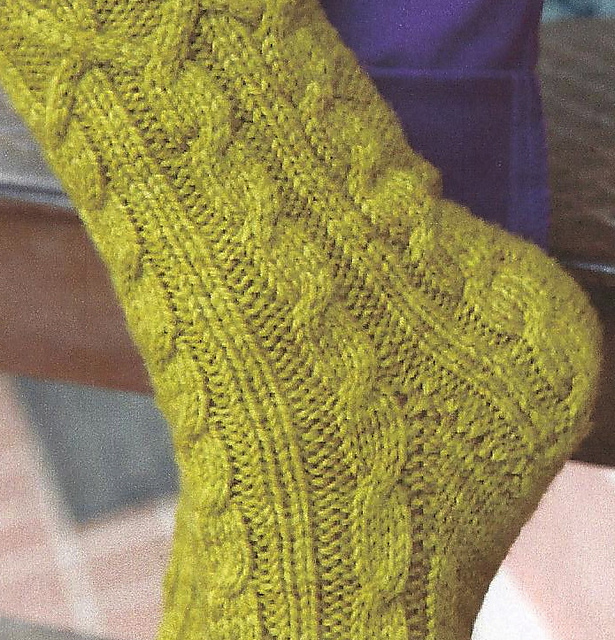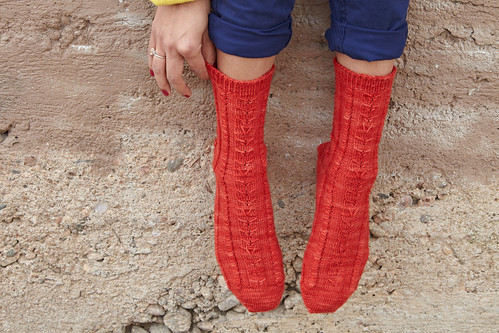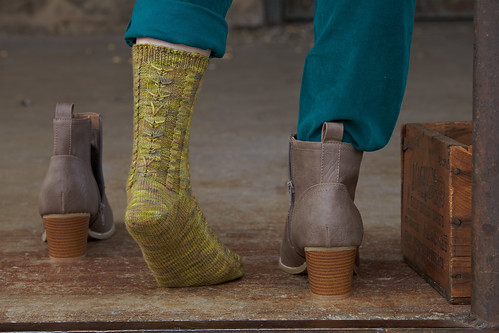
Second Day of Interviews – Kim Haesemeyer and Bowden Cable Socks
Kim Haesemeyer is the delightful designer of Bowden Cable Socks in Interweave’s most current issue of Sockupied. Kim is a pretty prolific designer, and has a variety of her patterns available at her Ravelry page. She most graciously agreed to answer some questions for me about her socks, and what inspires her. Without further ado, here is Kim:
How did you come up with the cable pattern?
Simple cables are some of my favorite stitch patterns to knit because with very little effort you have a wonderful new fabric. I wanted the cuff ribbing to naturally flow into the main cable pattern, so I just played with combinations until I found what I thought worked well. Plus, cabling is truly just another fancy ribbing since the pull-in of the stitches creates wonderful stretch to fit your foot nicely. This is also an ideal pattern to practice cabling without a cable needle.
How do you come up for names for your pattern?
Interweave chose the name for me and I love it! Classic with a bit of zing.
What is inspiring you right now? Do you have pictures, patterns or motifs?
I always have fun finding a particular part of a garment like the silhouette or stitch pattern and wonder how I can rework it for my purposes. What makes this garment work? What do I like about it? Would that stitch pattern a fun body pattern? Or just a hint of excitement along a neck or cuff edge? Would that work for a hat or mitten?
Why do you like to design socks?
Socks are a great way to try stitch patterns without having to commit to a huge garment. Plus, colors that may be too crazy for you to wear in other ways is the perfect amount of excitement in a pair of socks. Slightly zany socks absolutely brighten my day and even if the world cannot see them, I know they are there. If I am feeling more adventurous, I have seen the clear boots advertised in knitting magazines and thought they would be a fun way to showcase socks.
What do you hope to design in the future?
The exciting (and often overwhelming!) part of knitting design is how there are so many possibilities. I look forward to learning different sweaters and as well as other types of heels and toes in sock knitting.
What is your favorite item to knit?
I enjoy accessories because you can splurge on fancy yarn a bit if there isn’t too much yardage. I love to knit socks for the same reason — often just one hank makes the perfect pair and they travel well without taking up much space. Vests are my other favorite because they are so fast to knit seamlessly and they are the perfect layering piece to enjoy nearly year round.
Is there a favorite time of day you prefer to knit?
I like to process my day with my knitting so I have to knit at least for a bit in the evening. I have recently combined my two favorite things, knitting and reading, by listening to audio books. Why it took me so long to figure this out, I don’t know. Before I could only do one or the other, but now I can do both all day long!
Quick, your an animal! What are you? Why?
The ocean is my favorite and I always thought it would be amazing to explore the seas being a dolphin. Imagine how much they have seen that we know nothing about!
If you would like to learn more about Kim, visit her at her website, bigskyyarnsandcrafts.com.
To read yesterday’s interview with Claire on my blog visit here.
A Week of Interviews Claire Ellen and Uloborus

Today, Tuesday, we have an interview with Claire Ellen, who created the truly stunning Uloborus Socks. Claire is currently in Hungary in Karcag, and writes very eloquently about her experiences abroad. And without further ado, I’ll let Claire tell you about her Uloborus Socks, and the process they went through before they became what you see in Sockupied today.
Inspiration for Totem

Totem has the genesis in several different ideas. I was on the train home from one of Michael’s and my many journeys , and I had just finished Totoro, a slipped stitch pattern idea I had been playing with. I was proud of the design, but I knew that this slipped stitch technique could be pushed father; that I could do more with it.
So I started noodling around with the leftover yarn I had from Totoro. Because it was a highly varigated yarn, I knew I wanted a design that did a good job breaking up pooling. The first idea wasn’t quite right, so I pulled out some more yarn and made this first swatch.
Okay, that pattern was pretty cool. And the slipped stitches looked pretty neat. But I didn’t think it was enough. Was this really that different from what I did in Totoro? I’d already done slipped stitches once, and a new pattern had to be interesting enough not only for me to knit the swatch, but different enough to be accepted as a unique pattern submission. What else could I do?
I thought maybe I could add a cable, but I get frustrated when cables vanish in highly varigated yarns, and I wanted this to work with yarns like the one I was using. I’d just finished reading through The Principles of Knitting by June Hemmons Hiatt, and I remembered that she had used another type of slipped stitch – a wrapped stitch. Wrapped stitches would be perfect – not only would the necklace around the stitches stand out because of the yarn’s highly varigated nature, it would break up any pooling that could occur. Sweet.
So I swatched some more, and I thought the pattern was doing well – but it was getting awfully repetitive. Was there any way I could break it up periodically with something else? I went back to my pinterest board to look at stitch patterns I had favorited – nothing. So I went on Ravelry hoping that if I gave my brain a break something would pop up.
I came across a post that thesexyknitter (otherwise known as Sarah Wilson) on raverly posted about her pattern, Jon’s Sweater. It uses slipped stitches and the lateral braid to create a wonderfully subtle texture. I’d never heard of the lateral braid, but it looked so cool.
How hard could it be?
So I learned how to do it, using this video.
And then I added it to the pattern.
So now I had the pattern that you see here. It has the lateral braid, the slipped stitches, the wrapped stitches, and it’s the picture that I sent to Sockupied for my proposal.
What do you think? Have you ever done a lateral braid? How about wrapped stitches?
Totem
The official description: To work with the color shifts of handpainted yarn, Totem uses a type of slipped stitch in a geometric pattern that resembles the monumental cedar sculptures. A lateral braid creates the illusion of knit stitches rotated 90°.
Published in: Sockupied, Spring 2013
Craft: Knitting
Category: Feet / Legs → Socks → Mid-calf
Published: January 2013
Yarns suggested: Three Irish Girls Adorn Sock
Yarn weight: Fingering / 4 ply (14 wpi)
Gauge: 39 stitches and 52 rows = 4 inches
Needle size: US 1½ – 2.5 mm
Yardage: 430 – 600 yards (393 – 549 m)
Sizes available: 5 3/4, 7 1/2, 8 3/4″ circumference and 8 1/2, 10 1/4, 11 3/4″ long
This pattern is available for download for $7.99.
FINISHED SIZE 5¾ (7½, 8¾)” (14.5 19, 22 cm) foot circumference and 8½ (10¼, 11¾)” (21.5 26, 30 cm) long from back of heel to tip of toe; to fit women’s U.S. shoe size 6½ (8½, 10½). Socks shown measure 7½” (19 cm).
Notes: To accommodate a deep heel or high instep, you may choose to add additional stitches before the heel in the mini-gusset section, then decrease them in the purl column in the beginning of the leg.
If your foot circumference is larger (or smaller) than your ankle circumference, you may cast on more (or fewer) stitches in the foot section and decrease (or increase) as needed in the columns of knit stitches that divide the front and back of the sock.
Debating if the pattern is right for you? Got questions? This is the place to ask them!
Totem is Out!
About 15 minutes ago I was taking a break from working on writing a pattern for Sockupied that will be coming out in the Fall.

Totem, I’m happy to announce, is out. You can buy it on the Interweave website, and it’s a true steal. And it’s on the cover of Sockupied! (They’re the red ones, seen to the right.)
In the upcoming days I’ll be talking a little bit about the inspiration for Totem, early iterations, the design process for this sock, and a variety of other things!
Have you looked at the new Sockupied yet? Anything you see in the magazine that you’d like to work up?








